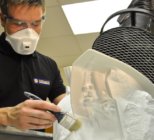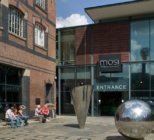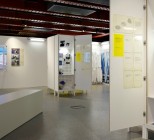Here M+H Advisor looks at how 3D Printing is starting to pique the interest of sector professionals with dedicated exhibitions at the Science Museum and Museum of Science and Industry (Mosi) and we focus on four case studies including work by Loughborough University to conserve museum objects in Beijing, Derby Silk Mill’s public workshops, The Centre for Computing History keeping up with technology and Museofabber as a facilitator for museums and schools to explore the educational possibilities of 3D printing.
CASE STUDY 1 CASE STUDY 2 CASE STUDY 3 CASE STUDY 4
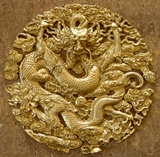



Loughborough Uni Derby Silk Mill Computing History Museofabber
Since 3D printing technology was developed in 1984 it has taken almost 30 years for museums to begin showing signs of implementing or finding uses for this new technology. The potential is definitely there for ways to utilise 3D printing from replicating objects for study, loans or retail as well as the conservation of objects.
National museums in both the UK and the US have taken the technology on board in various ways. In 2013 the V&A worked with Didit2Widgets, a London-based 3D printing firm, to make a non-working version of the world’s first 3D printed hand gun. Last year the British Museum announced it was working with Sketchfab, an online platform that lets users share and download 3D scans, to create 14 3D models of busts, including a marble bust of Zeus of first century origin, that people could download and print at home. The Smithsonian in Washington DC has launched a 3D database as it believes the technology has the potential, not only to support the Smithsonian mission, but to transform the museum’s core functions. In a more novel way, in November 2014, it teamed up with The White House to make an exact 3D replica of President Barack Obama.
In the case studies we can see how 3D printing is slowly filtering into the fabric of regional museums and how they are using it in different ways and how outside organisations are working with them to develop ideas. From museums who are hosting exhibitions dedicated to 3D printing to those who have bought a 3D printer for both exhibiting and making objects to sell, such as the Centre for Computing History in Cambridge, to museums commissioning the expertise of universities such as Loughborough to conserve their collection and Derby Silk Mill, which has made a 3D printer and used it in public workshops.
Collaboration
Wherever you look there will be some form of collaboration with 3D experts or the downloading of information from specialist websites as museum professionals’ grapple with the technical knowhow to maximise advantage. As many reasons as there are for museums to embrace this new technology there are as many against them adopting 3D printing – the main issues being the cost and time training staff. Museofabber, which is featured as a case study, has been working with museums, schools and universities to bridge this gap in knowledge and cost by providing the means to print objects from collections and use them in museums and educational establishments.
A firm indication that 3D printing is here to stay came at the end of 2012 when the contemporary science department at the Science Museum began to make plans for a dedicated exhibition entitled 3D: Printing the Future as they witnessed the growth of 3D printing in many disciplines, including the creative sector, with artists using the technology for new collections.
“We have regular meetings to determine what is zeitgiesty and to see what people are interested in for our future exhibitions,” says Rohan Mehra exhibitions content developer at the Science Museum.
“And by the beginning of 2013 we decided it was quite a big area that needed to be covered in the exhibition.
From October 2013 to December 2014 the museum welcomed around 1m visitors to the exhibition and has since used 3D printing in its latest exhibition Cravings: can food control you?
Current exhibition 3D: Printing the Future at Mosi
The Museum of Science and Industry (Mosi) has been running its own version of the 3D: Printing the Future exhibition, which runs until April 2015, and among its exhibits are artworks from Tobias Klyne with his Synthetic Heart, and Michaella Jans van Vuuren’s The Horse Marionette.


This demonstrates there is a potential for museums not only to think about working with their own collections but also with artists who are using the technology to make intricate artworks. Mosi assistant curator Sarah Baines also points to the practical opportunities the exhibition has brought to staff with the museum loaning a 3D printer, in order to give demonstrations, which has resulted in staff being competent working the machines and also in instructing others to use them.
“Our remit is science and technology so we are interested in the narrative and getting people involved in new technology,” says Baines.
“It means that a lot of our own curators have been able to use this and gain knowledge of how they work.
“We have learnt some of the issues with 3D printers and we have learnt how to use it from a technical point of view and also how to explain it to others – so this could prove useful in the future.”
As part of the exhibits is the world’s first fully 3D-printed metal bike frame, which makes it both stronger and lighter than if it was made using traditional manufacturing methods.
Experimenting
At the end of February the Royal Albert Memorial Museum (RAMM) became one of the latest museums to experiment with 3D printing. They teamed up with Exeter Library’s FabLab to explore the commercial potential of 3D printing objects in its collection. They scanned three Omo Bells, made by the Yoruba of Nigeria in the 19th century and used a Makerbot Replicator 5th generation 3D printer to print a half-sized replica.
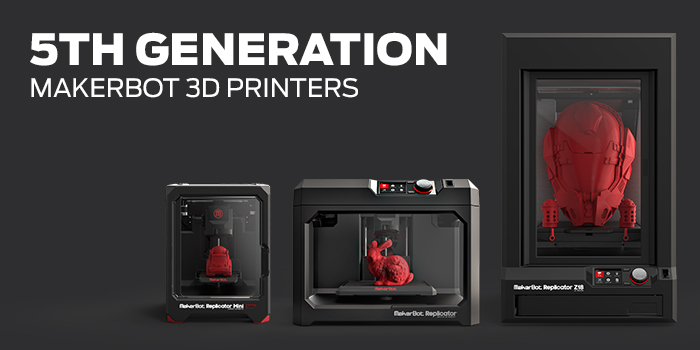
RAMM recently used a Makerbot 5th Generation to 3D print a 19th century bell from Nigeria
“I am interested in the commercial aspect and whether it would be possible to replicate masks in moulds maybe similar to the toys you have in cereal packets,” says Tony Eccles, curator of Ethnography.
“Museums shops directly connected to collections – is that commercially viable? The reason I did this was to find that out and see what the next step was.”
The initial results from the scanning were positive, producing a recognisable 3D model with much of the detail intact, however, RAMM still needs a little convincing before making the leap to buying a 3D printer.
“I think we are a long way away from buying a 3D printer. I would like to see some market research to see what members of the public feel about it and it really boils down to how 3D printing technology develops,” said Eccles.
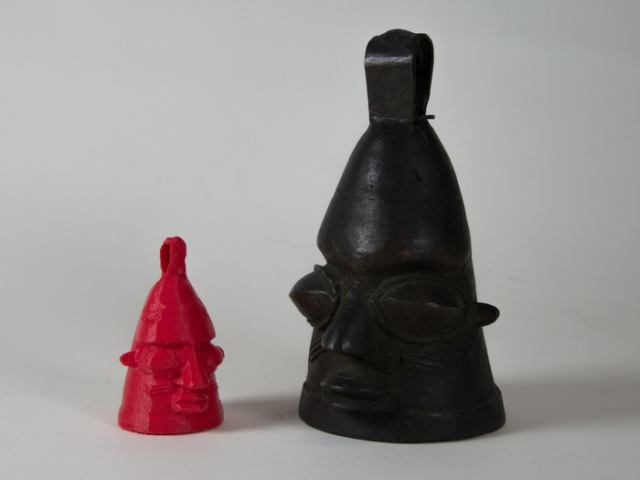
The Omo Bell, right, with its 3D-printed half size replica was an experiment in Februry 2015 by RAMM, Exeter into the viability of 3D printing objects for commercial sale
Things to consider when buying a 3D printer
With Hector Morton co-founder of Fablab Devon, a small-scale not-for-profit, community workshop offering digital fabrication.
What are the current price ranges for 3D printers?
At the lower end of the scale printers can be bought for just under £400. The Oma Bell was printed using a MakerBot Replicator 5th Generation, current price £2,199 ex vat. 3D printers can cost over a million pounds, Exeter University have an EOS P800 which is approximately £1m.
What would be a good entry level 3d printer in terms of price and performance and what could it offer a museum?
At the Fablab we also have an UP! Plus 3D Printer which is around £1,200 and very reliable. It offers single colour printing in ABS or PLA, can make parts up to 14.0cm long by 14.0cm wide by 13.5cm high and is very easy to use and small enough to be easily portable.
What are the main issues for museums and heritage attractions to consider before buying a 3d printer?
Reliability is one of the most important considerations, clogged heads and unlevel bases can cause malfunctions and down time. New 3D printers are being released all the time, some work better than others – look for a machine with proven reliability. 3D printers with strong metal frames are often more reliable than ones with plastic frames and have fewer issues with malfunctions due to less movement in the frame. Customer support is important and there should be a good warranty in case parts become damaged. Consider if you would like the build area enclosed behind a screen for safety and if portability is important to you.
Where are the best places for a museum to shop for a 3d printer or find more information?
Make magazine do a good Guide to 3D printing for 2015. Check manufacturer websites for product specifications and customer reviews for reliability.
Back to top

